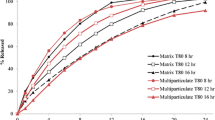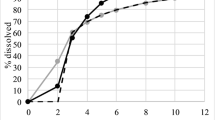Abstract
Purpose
To determine if an IVIVC model can predict PK profiles of varying formulations of a BCS Class 1 drug that is a salt of a weak base.
Method
An IVIVC model (Level A) was created by correlating deconvoluted in vivo absorption data obtained from oral administration of 50 mg, 100 mg, and 200 mg fast and slow extended release formulations with in vitro percent dissolved using residual regression analysis. The model was then used to predict the in vivo profile of five test products that varied in formulation characteristics.
Results
The model passed internal validation for predicted Cmax and AUC. For external validation, in vitro data of five different test formulations was utilized. The model passed external validation for two test formulations that were different but belonging to the same release mechanism as that of the reference formulation. Three formulations failed external validation because they belonged to either a mixed or different release mechanism. The model and results were further confirmed using GatstroPlus™ simulation software.
Conclusions
These observations indicate that an IVIVC model for a BCS class I drug may be applicable to varying formulations if the principle of the drug release is similar.











Similar content being viewed by others
Abbreviations
- AUC:
-
area under the curve
- BCS:
-
biopharmaceutics classification system
- Cmax :
-
maximum drug concentration observed in the blood plasma profile
- FRA:
-
fraction of drug absorbed into the body
- FRD:
-
fraction of drug dissolved during in vitro experimentation
- IVIVC:
-
in vitro–in vivo correlation
- ke :
-
constant of elimination
- MAPE:
-
mean absolute percentage error
- rpm:
-
revolutions per minute
- SUPAC-MR:
-
scale up post approval changes modified release
- Vd :
-
volume of distribution
- %PEAUC :
-
percent error of AUC prediction
- %PECmax :
-
percent error of Cmax prediction
References
US Pharmocopeia. In vitro and in vivo evaluation of dosage form. 1995;1824–929.
Food and Drug Administration. Guidance for industry: extended release oral dosage forms: development, evaluation, and application of in vitro/in vivo correlations. September 1997.
Rohrs BR, Burch-Clark DL, Witt MJ, Stelzer DJ. USP dissolution apparatus 3 (reciprocating cylinder): instrument parameter effects on drug release from sustained release formulations. J Pharm Sci. 1995;84(8):922–6. Epub 1995/08/01.
Hayes S, Dunne A, Smart T, Davis J. Interpretation and optimization of the dissolution specifications for a modified release product with an in vivo–in vitro correlation (IVIVC). J Pharm Sci. 2004;93(3):571–81. Epub 2004/02/06.
Zolnik BS, Burgess DJ. In vitro–in vivo correlation on parenteral dosage forms biopharmaceutics applications in drug development. In: Krishna R, Yu L, editors. Springer US; 2008. p. 336–58.
Lobenberg R, Okumu A, DiMaso M. Computer simulations using GastroPlus (TM) to justify a biowaiver for etoricoxib solid oral drug products. Eur J Pharm Biopharm. 2009;72(1):91–8.
Agoram B, Woltosz WS, Bolger MB. Predicting the impact of physiological and biochemical processes on oral drug bioavailability. Adv Drug Deliv Rev. 2001;50 Suppl 1:S41–67. Epub 2001/09/29.
Moore JWF, Flanner HH. Mathematical comparison of curves with an emphasis on dissolution profiles. Pharm Technol. 1996;20(6):10.
Shah VP, Tsong Y, Sathe P, Liu JP. In vitro dissolution profile comparison—statistics and analysis of the similarity factor, f2. Pharm Res. 1998;15(6):889–96. Epub 1998/07/01.
Eddington ND, Marroum P, Uppoor R, Hussain A, Augsburger L. Development and internal validation of an in vitro–in vivo correlation for a hydrophilic metoprolol tartrate extended release tablet formulation. Pharm Res. 1998;15(3):466–73. Epub 1998/05/01.
Mahayni H, Rekhi GS, Uppoor RS, Marroum P, Hussain AS, Augsburger LL, et al. Evaluation of “external” predictability of an in vitro–in vivo correlation for an extended-release formulation containing metoprolol tartrate. J Pharm Sci. 2000;89(10):1354–61. Epub 2000/09/12.
Lee SL, Raw AS, Yu L. Dissolution testing biopharmaceutics applications in drug development. In: Krishna R, Yu L, editors. Springer US; 2008. p. 47–74.
Verotta D. Volterra series in pharmacokinetics and pharmacodynamics. J Pharmacokinet Pharmacodyn. 2003;30(5):337–62. Epub 2004/02/24.
Junginger H. Excipients as absorption enhancers biopharmaceutics applications in drug development. In: Krishna R, Yu L, editors. Springer US; 2008. p. 139–74.
Chidambaram N, Porter W, Flood K, Qiu Y. Formulation and characterization of new layered diffusional matrices for zero-order sustained release. J Control Release. 1998;52(1–2):149–58. Epub 1998/08/01.
Hardy IJ, Windberg-Baarup A, Neri C, Byway PV, Booth SW, Fitzpatrick S. Modulation of drug release kinetics from hydroxypropyl methyl cellulose matrix tablets using polyvinyl pyrrolidone. Int J Pharm. 2007;337(1–2):246–53.
Halsas M, Ervasti P, Veski P, Jurjenson H, Marvola M. Biopharmaceutical evaluation of time-controlled press-coated tablets containing polymers to adjust drug release. Eur J Drug Metab Pharmacokinet. 1998;23(2):190–6. Epub 1998/09/02.
Halsas M, Hietala J, Veski P, Jurjenson H, Marvola M. Morning versus evening dosing of ibuprofen using conventional and time-controlled release formulations. Int J Pharm. 1999;189(2):179–85. Epub 1999/10/28.
Qureshi S. In vitro–in vivo correlation (IVIVC) and determinating drug concentrations in blood from dissolution testing—a simple and practical approach. Open Drug Deliv J. 2010;4:38–47.
ACKNOWLEDGMENTS AND DISCLOSURES
The findings and conclusions in this presentation have not been formally disseminated by the Food and Drug Administration and should not be construed to represent any Agency determination or policy.
Author information
Authors and Affiliations
Corresponding author
Rights and permissions
About this article
Cite this article
Mirza, T., Bykadi, S.A., Ellison, C.D. et al. Use of In Vitro–In Vivo Correlation to Predict the Pharmacokinetics of Several Products Containing a BCS Class 1 Drug in Extended Release Matrices. Pharm Res 30, 179–190 (2013). https://doi.org/10.1007/s11095-012-0861-y
Received:
Accepted:
Published:
Issue Date:
DOI: https://doi.org/10.1007/s11095-012-0861-y




